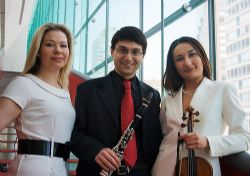|
Symphony
SRS SEASON ENDS WITH RESOUNDING TA-TA-TA-BANG
by Terry McNeill
Sunday, June 1, 2025
Symphony
YOUTHFUL VIRTUOSITY ON DISPLAY AT USO'S MAY CONCERTS
by Peter Lert
Saturday, May 17, 2025
Symphony
MYSTICAL PLANETS AND LIVELY GERSHWIN ORTIZ AT FINAL SRS CONCERT
by Peter Lert
Sunday, May 4, 2025
Symphony
VSO'S CONCERT MUSIC OF TIME, MUSIC OF PLACE
by Peter Lert
Sunday, April 27, 2025
Choral and Vocal
VOCAL ELEGANCE AND FIRE AT THE 222'S RECITAL APRIL 26
by Pamela Hicks Gailey
Saturday, April 26, 2025
CANTIAMO SONOMA SINGS AN INSPIRED GOOD FRIDAY MOZART REQUIEM CONCERT
by Pamela Hicks Gailey
Friday, April 18, 2025
DRAMATIC SHOSTAKOVICH SYMPHONY CLOSES PHILHARMONIC'S 25TH SEASON
by Terry McNeill
Sunday, April 13, 2025
LARGE COLLEGE OF MARIN AUDIENCE GREETS STOPHER ARTISTRY
by Terry McNeill
Saturday, April 5, 2025
Chamber
FRISSON DELIVERS SHIVERS OF DELIGHT
by Abby Wasserman
Sunday, March 30, 2025
OLD AND MOSTLY NEW IN SRS MARCH CONCERT IN WEILL
by Peter Lert
Saturday, March 22, 2025
|
 |
 Prima Trio |
PRIMA TRIO'S COLORFUL MIX AT MILL VALLEY CHAMBER
by Kate Gilpin
Sunday, January 17, 2016
Softly falling rain and a glimpse of rain-green trees through the windows of the Mount Tamalpais Methodist Church was the ideal background for a stunning Mill Valley Chamber Music Society performance Jan. 17.
The Prima Trio, a young group comprising transplants from Armenia, Uzbekistan, and Russia, combined individual virtuosity with instrumental interplay that provided a perfect blend of sound. The interesting mix of clarinet, violin/viola, and piano made for one surprise after another, as the players bounced themes and harmonies back and forth.
The first half included Mozart’s E-Flat Major Trio (“Kegelstatt”), K. 498; a selection from Bruch’s Eight Pieces, Op. 83; and an astonishing Srul Glick work “The Klezmer’s Wedding.” After the intermission the Prima played Khachaturian’s first published composition, then a Piazzolla tango, and a finale of Peter Schickele’s “Serenade for Three.”
The performers included clarinetist Boris Allakhverdyan, the Principal Clarinet of the Metropolitan Opera Orchestra. His playing is brilliant, melancholy and boisterous by turns. Gulia Gurevich, played violin and viola. Her artistry is breathtaking, dramatic, plaintive and occasionally raucous! Pianist Anastasia Dedik's artistry is consistently masterful.
The Mozart Trio is first known use of the clarinet-viola-piano combination, and opens atypically with an Andante, followed by a more lively minuet, and finishes with a rather rhapsodic seven-part rondo. The instrumentation makes for a gorgeous liquid sound, and the Prima delivered it beautifully.
We often associate klezmer music with the clarinet and this performance Of Glick's "The Klezmer's Wedding" did not disappoint, as Mr. Allakhverdyan played wonderful instrumental slides, syncopated rhythms and other features associated with the klezmer tradition. More surprising was the colorful klezmic quality shown in the string and piano parts. It was a thrilling piece, much of the music being in 3/4 time, which added even more charm to the work, and brought the audience to its feet in a standing ovation.
Of great interest to this reviewer was the Khachaturian G Minor Trio, opening, like the Mozart with an Andante movement, then continuing to an Allegro and finally a Moderato. The characteristically lush melodic and rhythmic features of Khachaturian were all to be heard in this piece, known, as noted above, as the first thing he ever composed. In particular, the last movement of the 1932 work was haunting, trailing off to a final silence.
The Argentine composer Astor Piazzolla’s music has been increasingly popular in recent years. His “Otoño Porteño” from 1969 is the second of a four-part suite celebrating the seasons in Buenos Aires, and is an illustration of the “nuevo tango” for which the composer has become known. With the verve and flair that characterized the entire program, the Prima played with finished artistry. The afternoon’s program concluded with Schickele’s 12-minute three-part Serenade for B Flat clarinet, violin and piano.
It was an afternoon of strong musical contrasts: from Mozart to klezmer, gypsy coloring to tango, and finally music marked “fast and rowdy”
|
